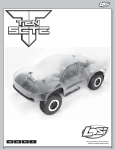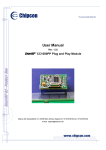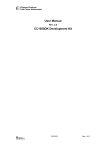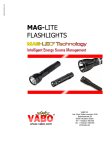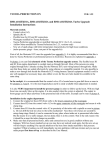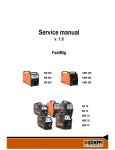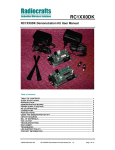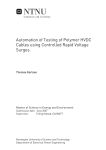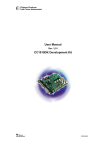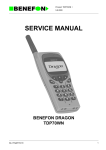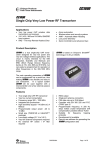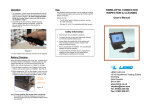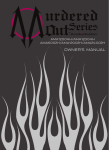Download CC1000 Data Sheet
Transcript
User Manual Rev. 2.11 CC1000DK Development Kit SWRU058 Page 1 of 24 Table of contents: INTRODUCTION ....................................................................................................................... 3 EVALUATION BOARD ............................................................................................................. 3 DESCRIPTION ........................................................................................................................... 4 LAYOUT SKETCHES, ASSEMBLY DRAWINGS AND CIRCUIT DIAGRAM ............................................. 10 BILL OF MATERIALS ................................................................................................................. 17 USING THE DEVELOPMENT KIT.......................................................................................... 22 GENERAL INFORMATION .......................................................................................................... 23 SWRU058 Page 2 of 24 Introduction The CC1000 single chip transceiver includes many features and great flexibility which makes the chip suitable for a very large number of applications and system requirements. The CC1000DK Development Kit is designed to make it very easy for the user to evaluate transceiver performance and in short time develop his own applications. The Development Kit includes two evaluation boards with a complete CC1000 transceiver, voltage regulator and PC interface circuitry. Using the evaluation board connected to a PC running the SmartRF® Studio software, various system parameters can be changed and tested by keystrokes. Technical features: - RF power up to 10 mW (10 dBm) programmable in 1dB steps -109 dBm sensitivity for 10-3 bit error rate - Logic level data input/output (Manchester coded or NRZ) - Logic level synchronisation clock output - RSSI output - 10.7 MHz IF output - Selectable RF filtering (SAW or LC) - All set-up controlled by PC - Selectable 3V or 4-10Vunregulated voltage supply inputs This user manual describes how to get started with the Development Kit. You will also find detailed description of the evaluation board and advice how to develop your own applications. For details on how to use the SmartRF® Studio software please refer to the SmartRF® Studio User Manual. Your SmartRF® CC1000DK Development Kit should contain the following items: Evaluation Board (CC1000EB) 2 ex PC parallel port extension cable 2 ex 25-pin D-sub, male-female, 3m Adapter 6 ex SMA male-BNC female Antenna 2 ex 50Ω, λ/4 monopole, SMA male CC1000 samples 5 ex Quick Start User Manual SmartRF® CD-ROM The evaluation board includes a significant number of components for great flexibility. However, only a minor part of these components are required in an actual application. Check the datasheet for a typical application circuit. Evaluation Board The kit includes an Evaluation Board (CC1000EB) with the following items: SWRU058 Page 3 of 24 • A SmartRF® CC1000 chip. • Necessary external surface mounted devices, SMDs, for the chip. • Voltage regulator 4V-10V to 3V regulated voltage. • Possibilities to apply a 3V voltage source directly (chosen by the switch on the board). • Voltage-level interface circuits between the CC1000 chip (3V) and the parallel port of the computer (5V). • Connector for a PC parallel port cable. • Connector for antenna, modulation data in/out, synchronisation clock out, RSSI out and IF out. • Edge connector for future use. This board is designed with great flexibility so that you can evaluate the circuit performance for several circuit configurations, and in development of your own applications. A layout sketch of the evaluation board is shown in chapter 0. The evaluation board is distributed in two versions, and the difference is the frequency band of operation. The two versions are optimised for 434 MHz and 869 MHz to cover the two licence free band in Europe. The operating frequency band is marked on the Evaluation Board. Description The evaluation circuit board constitutes of three main parts. These are the RF-section, the voltage supply and the PC-interface. The PC-interface contains voltage level shift circuit, which buffers the control lines. Voltage supply You can chose between applying a 4-10V non-regulated supply voltage or a 3V regulated supply voltage by setting a switch on the board (SPDT). If a non-regulated supply voltage is applied, an on board regulator generates a regulated 3V supply. A diode prevents damage if wrong polarity is used for the non-regulated input. The connector has five contacts, which is shown below. In addition to the three supply voltage contacts, there are two contacts, which can be used to measure the DC current to the CC1000 chip. A short jumper is placed between these two contacts for the circuit to work. If you want to measure the DC current, replace the jumper with an amperemeter (as shown in the figure below). The current range is from 0 to 26 mA. SWRU058 Page 4 of 24 4-10V 0V 3V A Iout Iin Figure: The power connector with an amperemeter attached. RF-section The RF section consists of a CC1000 chip with external components. The different components are explained below. The loop filter The CC1000 has integrated the loop-filter and shaping features on-chip. For flexibility it is also possible to use an external loop-filter. The PLL loop filter contains the components C121-C122 and R121. However, in most cases the internal filter will give the optimum performance. The loop filter is connected to the same pin as the monitoring of the lock indicator (see 2.1.4). When external loop-filter is added, the R122 must be removed to avoid conflict with the lock line connected to the parallel port. The LOCK signal A LOCK signal is connected to the parallel port interface to be monitored by the software. The signal tells you if the synthesiser frequency is in lock. It is also available at a test pin, TP2, and is active high. This digital output can also be configured to other functions, as control signal for external PA or external LNA. Please see the data sheet for details. Note: To monitor this signal CC1000 must be configured to take out this signal on CHP_OUT. This is the default setting of SmartRF® Studio. If external loop filter is added the lock signal can not be used due to the loop filter is connected to the same pin. SWRU058 Page 5 of 24 DIO and DCLK The modulation input/output (DIO) and the synchronisation output (DCLK) is connected to separate connectors. The connectors are of SMA female type. The data to be sent can be of either Manchester or NRZ. The Manchester code ensures that the signal has no DC component. The Manchester code is based on transitions; a “0” is encoded as a low-to-high transition, a “1” is encoded as a high-to-low transition. See figure below. Maximum data-rate is 9.6 kbit/s giving a baud rate of 19.2 kbaud that is chosen in the software. For NRZ the baud rate is equal to the bit rate and is maximum 19.2 kbaud. To test your module use a 3Vpp logic level with 1-10 kHz square wave for Manchester coded data and 1- 20 kHz square wave for NRZ data. The CC1000 has an internal clock synchronisation circuit that can be monitored on DCLK. The relationship between DIO and DCLK is given below, for the different modes of C1000. Please see datasheet for details. SWRU058 Page 6 of 24 Synchronous NRZ mode Synchronous Manchester encoded mode Transparent Asynchronous UART mode SWRU058 Page 7 of 24 RSSI/IF The RSSI/IF is connected to a separate connector of SMA female type. This pin is connected from the CC1000 via a serial resistor (R280), and a shunt R (R281) and C(C281). The default of this components is set to give out RSSI information, and the measured voltage will be between 0 - 1.2 V. Based on this voltage the received signal strength can be calculated as given in the CC1000 data sheet. The RSSI/IF can also be configured to take out the 10.7 MHz IF frequency. This is useful if an external demodulator is needed for narrow band applications. This demodulator can easily be connected to the RSSI/IF connector. The components R180, R181, and C181 must in this case be changed to matching elements. Please see the data sheet for details. LNA/PA matching The input/output matching network is optimised for either 434 MHz or 868 MHz operation. The component values are calculated in the software program, and consist of L41, L42, C51, L51 and C52. Using the specified component values for the input/output match will give an optimum match at the specified operating frequency. Minor tuning of the component values may be necessary to compensate for layout parasitics at other frequencies or other layouts. The crystal oscillator Crystal frequency is set to 14.7456 MHz, X1. The crystal oscillator circuit has a trimmer capacitor, CT152, which reduces the initial tolerance of the crystal to zero by careful adjustment using a precision frequency counter. The crystal used at this board has ±10 ppm accuracy and ±10 ppm over the –10 to +70 °C temperature range. The crystal oscillator has an AC coupled (C153) test pin for external clock injection, TP1. Be sure to remove the crystal when an external clock is used. The external clock should have amplitude of 1-3Vpp. The loading capasitors are designed for a 12 pF crystal load. The RF filter options There are three RF filter options: LC-filter, SAW filter, or no filter used. Each of the three filter alternatives is equipped with a female SMA antenna connector. To choose between the three filters there is a zero ohm resistor that can be moved (R61-R63). Unfiltered antenna output To select an unfiltered this output the zero ohm resistor must be put in R61, and R62 and R63 shall not be mounted. LC-filtered antenna output SWRU058 Page 8 of 24 To choose the LC filtered antenna output the zero ohm resistor must be put in the R62 position. A LC-filter consisting of L52, C52 and C53 make up a 3dB-equal ripple low-pass filter that prevents harmonics to be emitted from the transmitter. In receive mode the filter removes high frequencies in order to prevent distortion and jamming of the receiver. The filter is designed for 50Ω termination impedance. The LC-filter is selected by placing the zero ohm resistor in the R62 position. For operation at other frequencies, use the formulas below. 1 ⎛ ⎞ ⎟, ⎝ 1 − 0.1333 ⎠ ω C ≈ ω RF ⋅ ⎜ L= 35.6 ωC , C= 0.067 ωC , where ωC is the cut-off frequency and ωRF is the transmitted RF frequency . SAW filtered antenna output To choose the SAW filtered antenna output the zero ohm resistor must be put in the R63 position. The components around the filter (F2) can be changed to match any SAW filter type. The SAW filter will introduce additional loss, but will increase the selectivity of the receiver. SWRU058 Page 9 of 24 Layout sketches, assembly drawings and circuit diagram SWRU058 Page 10 of 24 SWRU058 Page 11 of 24 SWRU058 Page 12 of 24 SWRU058 Page 13 of 24 SWRU058 Page 14 of 24 SWRU058 Page 15 of 24 SWRU058 Page 16 of 24 Bill of materials RF part 434 MHz Reference Description Value Part C3 Capacitor, tantal 3,3 uF C_3u3_B C5 Capacitor 0805 220 pF C_220P_0805_NP0_G_50 C6 Capacitor 0805 33 nF C_33N_0805_X7R_J_50 C10 Capacitor 0603 1 nF C_1N0_0603_X7R_K_50 C11 Capacitor 0805 33 nF C_33N_0805_X7R_J_5 C12 Capacitor 0603 1 nF C_1N0_0603_X7R_K_50 C13 Capacitor 0603 220 pF C_220P_0603_NP0_G_50 C14 Capacitor 0603 220 pF C_220P_0603_NP0_G_50 C41 Capacitor 0603 15 pF C_15P_0603_NP0_J_50 C51 Capacitor 0603 8.2 pF C_8P2_0603_NP0_J_50 C52 Capacitor 0603 5.6 pF C_5P6_0603_NP0_J_50 C62 Capacitor 0805 220 pF C_220P_0805_NP0_G_50 C63 Capacitor 0603 5.6 pF C_5P6_0603_NP0_C_5 C68 Capacitor 0603 5.6 pF C_5P6_0603_NP0_C_50 C71 Capacitor 0603 15 pF C_15P_0603_NP0_J_50 C72 Capacitor 0603 22 pF C_22P_0603_NP0_J_50 C121 Capacitor 0603 Not used C122 Capacitor 0603 Not used C131 Capacitor 0603 4.7 pF C_4P7_0603_NP0_C_50 C141 Capacitor 0603 8.2 pF C_8P2_0603_NP0_G_50 C151 Capacitor 0603 6.8 pF C_6P8_0603_NP0_J_50 C153 Capacitor 0603 1 nF C_1N0_0603_X7R_K_50 C210 Capacitor 0603 1 nF C_1N0_0603_X7R_K_50 C281 Capacitor 0603 1 nF C_1N0_0603_X7R_K_50 CT152 Trimmer Capacitor C_3-10P_TRIM_NP0 F2 SAW-filter, 433.92 MHz B3550 (Epcos) L42 Inductor 0805 68 nH L_68N_0805_J L51 Inductor 0805 6.2 nH L_6N2_0805_J L64 Inductor 0805 33 nH L_33N_0805_J L67 Inductor 0805 33 nH L_33N_0805_J SWRU058 Page 17 of 24 L71 Inductor 0805 8.2 nH L_8N2_0805_J L91 Inductor 0805 33 nH L_33N_0805_J (Koa KL732ATE33NJ) L210 EMI filter bead BLM11A102S (Murata) R24 Not used R51 Not used R61 Resistor 0805 0R_0805 R62 Not used R63 Not used R121 Not used R122 Resistor 0603 0R, 0603 R131 Resistor 0603 R_82K_0603_F R153 Not used R280 Resistor 0603 0R_0603 R281 Resistor 0603 R_27K_0603_G TP1 Testpoint TESTPIN TP2 Testpoint TESTPIN U1 Single chip transceiver CC1000 X1 Crystal, HC-49-SMD X_14.7456/10/10/10/12 RF part 869 MHz Reference Description Value Part C3 Capasitor, tantal 3,3 uF C_3u3_B C5 Capasitor 0805 220 pF C_220P_0805_NP0_G_50 C6 Capacitor 0805 33 nF C_33N_0805_X7R_J_50 C10 Capacitor 0603 1 nF C_1N0_0603_X7R_K_50 C11 Capacitor 0805 33 nF C_33N_0805_X7R_J_5 C12 Capacitor 0603 1 nF C_1N0_0603_X7R_K_50 C13 Capacitor 0603 220 pF C_220P_0603_NP0_G_50 C14 Capacitor 0603 220 pF C_220P_0603_NP0_G_50 C41 Capacitor 0603 10 pF C_10P_0603_NP0_J_50 C51 Capacitor 0603 C52 Capacitor 0603 4.7 pF C_4P7_0603_NP0_J_50 C62 Capacitor 0805 220 pF C_220P_0805_NP0_G_50 Not used SWRU058 Page 18 of 24 C63 Capacitor 0603 3.3 pF C_3P3_0603_NP0_C_50 C68 Capacitor 0603 3.3 pF C_3P3_0603_NP0_C_50 C71 Capacitor 0603 8.2 pF C_8P2_0603_NP0_G_50 C72 Capacitor 0603 8.2 pF C_8P2_0603_NP0_G_50 C121 Capacitor 0603 Not used C122 Capacitor 0603 Not used C131 Capacitor 0603 4.7 pF C_4P7_0603_NP0_C_50 C141 Capacitor 0603 8.2 pF C_8P2_0603_NP0_G_50 C151 Capacitor 0603 6.8 pF C_6P8_0603_NP0_J_50 C153 Capacitor 0603 1 nF C_1N0_0603_X7R_K_50 C210 Capacitor 0603 1 nF C_1N0_0603_X7R_K_50 C281 Capacitor 0603 1 nF C_1N0_0603_X7R_K_50 CT152 Trimmer Capacitor C_3-10P_TRIM_NP0 F2 SAW-filter, 868.6 MHz B3571 (Epcos) L42 Inductor 0805 120 nH L_120N_0805_J L51 Inductor 0805 2.5 nH L_2N5_0805_J L64 Inductor 0805 15 nH L_15N_0805_J L67 Inductor 0805 15 nH L_15N_0805_J L71 Inductor 0805 3.3 nH L_3N3_0805_J L91 Inductor 0805 4.7 nH L_4N7_0805_J (Koa KL732ATE4N7C) L210 EMI filter bead BLM11A102S (Murata) R24 Not used R51 Not used R61 Resistor 0805 0R_0805 R62 Not used R63 Not used R121 Not used R122 Resistor 0603 0R, 0603 R131 Resistor 0603 R_82K_0603_F R153 Not used R280 Resistor 0603 0R_0603 R281 Resistor 0603 R_27K_0603_G TP1 Testpoint TESTPIN TP2 Testpoint TESTPIN SWRU058 Page 19 of 24 U1 Single chip transceiver CC1000 X1 Crystal, HC-49-SMD X_14.7456 /10/10/10/12 Voltage regulator Reference Description Value Part C1 Capacitor, tantal 3.3µF C_3U3_TAN_B C2 Capacitor, tantal 3.3µF C_3U3_TAN_B R29 Resistor 0603 Not used D1 Diode, Si BAT254 Q1 MOSFET, P ch. SI9424DY, Siliconix S1 SPDT switch SWITCH_SPDT U2 Voltage regulator LP2981, 3V, National Semiconductor PC interface Reference Description Value Part C26 Capacitor 0805 33nF C_33N_0805_X7R_J_50 C27 Capacitor 0805 33nF C_33N_0805_X7R_J_50 Q2 BJT, Si, NPN, small signal BC846 Q3 BJT, Si, NPN, small signal BC846 Q4 BJT, Si, NPN, small signal BC846 Q5 BJT, Si, NPN, small signal BC846 Q6 BJT, Si, NPN, small signal BC846 R1 Resistor 0603 10kΩ R_10K_0603_G R2 Resistor 0603 10kΩ R_10K_0603_G R3 Resistor 0603 10kΩ R_10K_0603_G R4 Resistor 0603 10kΩ R_10K_0603_G R5 Resistor 0603 10kΩ R_10K_0603_G R6 Resistor 0603 10kΩ R_10K_0603_G R7 Resistor 0603 10kΩ R_10K_0603_G R8 Resistor 0603 10kΩ R_10K_0603_G R9 Resistor 0603 10kΩ R_10K_0603_G R10 Resistor 0603 10kΩ R_10K_0603_G R11 Resistor 0603 10kΩ R_10K_0603_G R12 Resistor 0603 10kΩ R_10K_0603_G SWRU058 Page 20 of 24 R13 Resistor 0603 10kΩ R_10K_0603_G R14 Resistor 0603 10kΩ R_10K_0603_G R15 Resistor 0603 10kΩ R_10K_0603_G R16 Resistor 0603 10kΩ R_10K_0603_G R17 Resistor 0603 10kΩ R_10K_0603_G R18 Resistor 0603 10kΩ R_10K_0603_G R19 Resistor 0603 10kΩ R_10K_0603_G R20 Resistor 0603 100kΩ R_100K_0603_G R21 Resistor 0603 100kΩ R_100K_0603_G R22 Resistor 0603 100kΩ R_100K_0603_G R23 Resistor 0603 100kΩ R_100K_0603_G R25 Resistor 0603 100kΩ R_100K_0603_G R26 Resistor 0603 10kΩ R_10K_0603_G R27 Resistor 0603 10kΩ R_10K_0603_G R28 Resistor 0603 10kΩ R_10K_0603_G U3 Hex inverter, oc 74HC05 U4 Hex inverter, oc 74HC05 Evaluation board Reference Description Value Part H1 Circuit Board Support Distance 12.5mm H2 Circuit Board Support Distance 12.5mm H3 Circuit Board Support Distance 12.5mm H4 Circuit Board Support Distance 12.5mm P1 D-Sub, 25 pin DSUB_25 P2 5 pin terminal, screw SCREW_TERM_5 P3 SMA connector SMA (Straight) P4 SMA connector SMA (Straight) P5 SMA connector SMA (Straight) P6 SMA connector SMA_RA (Right angle) P7 SMA connector SMA_RA (Right angle) P9 SMA connector SMA_RA (Right angle) P8 Edge connector, 2 x 8 pin EDGE_CONN_2X8 Note: Items shaded are different for different frequencies SWRU058 Page 21 of 24 Using the Development Kit The purpose of the Development Kit is to give users of the integrated transceiver CC1000 hands-on experience with the chip. A typical set-up of the evaluation board is shown below. Each of the evaluation boards is connected to a PC to be programmed by the software. • How to set up a transmitter. The data signal that you want to send in transmit mode can be of either Manchester or NRZ code. A square wave from a function generator can be used to generate this data. The signal source shall be connected to the Data I/O port (DIO) at the evaluation board. The signal must be a square wave from 0 to 3V as shown. Do not apply a 5V signal because it can damage the CC1000 chip. The signal from the function generator will represent either zeroes or ones, and the bit rate in Manchester coded will be 1/T, where T is the period time. For the NRZ case, the bit rate is given by 2/T due to the fact that the bit rate is equal to the baud rate in NRZ. 3V 0V T The transmitted signal can be studied on a spectrum analyser, sent out on the antenna (see note below) or sent to the receiver via a cable with an attenuator attached. Figure: Equipment set-up in transmit mode. SWRU058 Page 22 of 24 • How to set up a receiver In receive mode a RF generator can be connected to the antenna input to give an ideal RF signal to the circuit board for testing the receiver. Use FSK modulation with appropriate deviation and modulation rate. If you don’t have the equipment to send FSK modulation, you can use a RF generator with FM modulation and use an external function generator to modulate the signal with a square wave. The RF signal can also come from the transmitter via the antenna. An oscilloscope is used to see the signal that is being received. Figure: Equipment set-up in receive mode. Important: The use of radio transceivers is regulated by international and national rules. Before transmitting a RF signal out on the antenna, please contact your local telecommunication authorities to check if you are licensed to operate the transceiver. General Information Chipcon AS believes the furnished information is correct and accurate at the time of this printing. However, Chipcon AS reserves the right to make changes to this product without notice. Chipcon AS does not assume any responsibility for the use of the described product. Please refer to Chipcon’s web site for the latest update. SmartRF® is a registered trademark of Chipcon AS. SmartRF® is Chipcon's RF technology platform with RF library cells, modules and design expertise. Based on SmartRF® Chipcon develops standard component RF-circuits as well as full custom ASICs based on customers' requirements. SWRU058 Page 23 of 24























